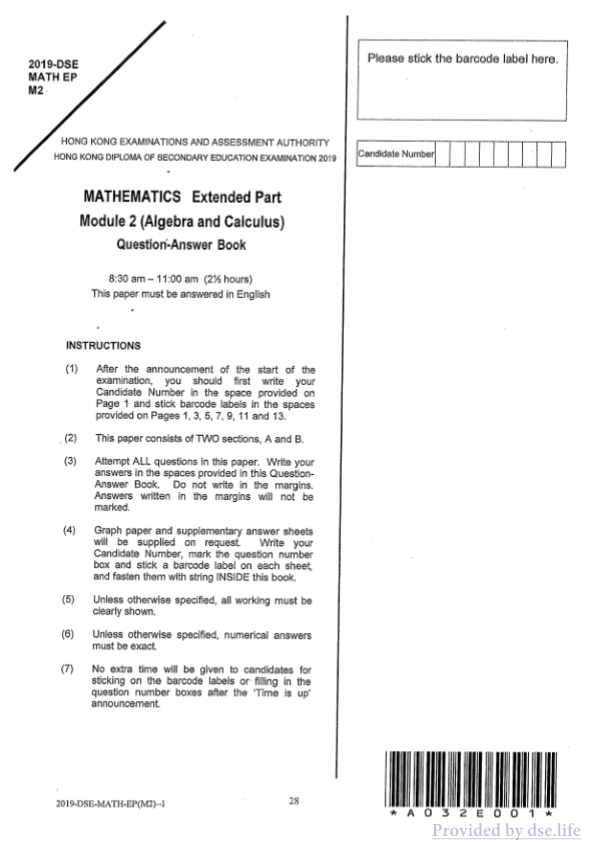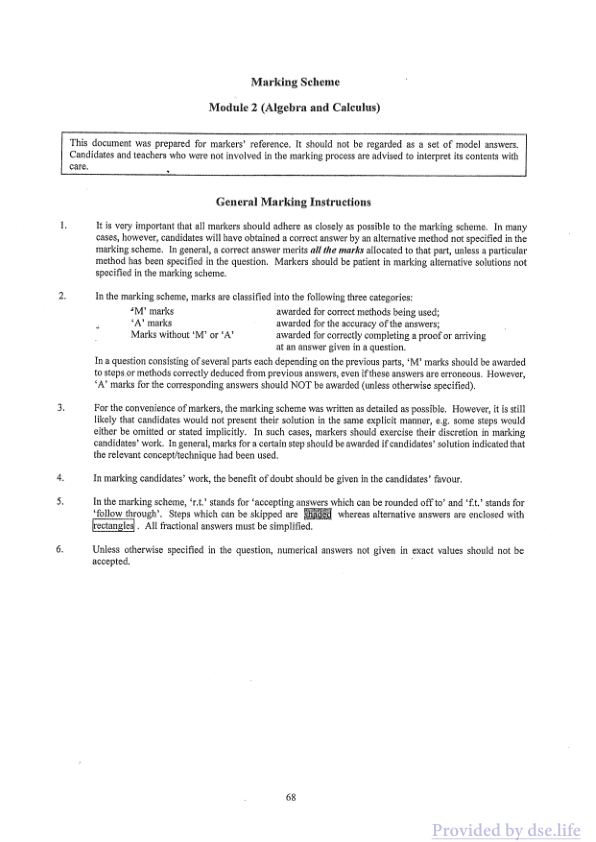2019 DSE 数学延伸部分-M2 真题 答案 详解
| 序号 | 文件列表 | 说明 | ||
|---|---|---|---|---|
| 1 | 2019-数学延伸部分-M2-paper-eng.pdf | 28 页 | 1.80MB | 真题(英文) |
| 2 | 2019-数学延伸部分-M2-paper-zh.pdf | 28 页 | 2.09MB | 真题(中文) |
| 3 | 2019-数学延伸部分-M2-answer-eng.pdf | 14 页 | 1.12MB | 答案(英文) |
真题(英文)
2019-DSE MATH EP M2
HONG KONG EXAMINATIONS AND ASSESSMENT AUTHORITY HONG KONG DIPLOMA OF SECONDARY EDUCATION EXAMINATION 2019
MATHEMATICS Extended Part Module 2 (Algebra and Calculus) Question-Answer Book
8:30 am - 11:00 am (2½ hours)
This paper must be answered in English
INSTRUCTIONS
(1) After the announcement of the start of the examination, you should first write your Candidate Number in the space provided on Page 1 and stick barcode labels in the spaces provided on Pages 1, 3, 5, 7, 9, 11 and 13.
(2) This paper consists of TWO sections, A and B.
(3) Attempt ALL questions in this paper. Write your answers in the spaces provided in this Question-Answer Book. Do not write in the margins. Answers written in the margins will not be marked.
(4) Graph paper and supplementary answer sheets will be supplied on request. Write your Candidate Number, mark the question number box and stick a barcode label on each sheet, and fasten them with string INSIDE this book.
(5) Unless otherwise specified, all working must be clearly shown.
(6) Unless otherwise specified, numerical answers must be exact.
(7) No extra time will be given to candidates for sticking on the barcode labels or filling in the question number boxes after the 'Time is up' announcement.
2019-DSE-MATH-EP(M2)-1 28
- A 0 3 2 E 0 0 1 * Provided by dse.life

真题(中文)

答案(英文)
Marking Scheme
Module 2 (Algebra and Calculus)
This document was prepared for markers’ reference. It should not be regarded as a set of model answers. Candidates and teachers who were not involved in the marking process are advised to interpret its contents with care.
General Marking Instructions
1. It is very important that all markers should adhere as closely as possible to the marking scheme. In many cases, however, candidates will have obtained a correct answer by an alternative method not specified in the marking scheme. In general, a correct answer merits all the marks allocated to that part, unless a particular method has been specified in the question. Markers should be patient in marking alternative solutions not specified in the marking scheme.
2. In the marking scheme, marks are classified into the following three categories:
- 'M' marks awarded for correct methods being used;
- 'A' marks awarded for the accuracy of the answers;
- Marks without ‘M’ or ‘A’ awarded for correctly completing a proof or arriving at an answer given in a question.
In a question consisting of several parts each depending on the previous parts, ‘M’ marks should be awarded to steps or methods correctly deduced from previous answers, even if these answers are erroneous. However, ‘A’ marks for the corresponding answers should NOT be awarded (unless otherwise specified).
3. For the convenience of markers, the marking scheme was written as detailed as possible. However, it is still likely that candidates would not present their solution in the same explicit manner, e.g., some steps would either be omitted or stated implicitly. In such cases, markers should exercise their discretion in marking candidates’ work. In general, marks for a certain step should be awarded if candidates’ solution indicated that the relevant concept/technique had been used.
4. In marking candidates’ work, the benefit of doubt should be given in the candidates’ favour.
5. In the marking scheme, ‘r.t.’ stands for ‘accepting answers which can be rounded off to’ and ‘f.t.’ stands for ‘follow through’. Steps which can be skipped are shaded whereas alternative answers are enclosed with rectangles. All fractional answers must be simplified.
6. Unless otherwise specified in the question, numerical answers not given in exact values should not be accepted.

